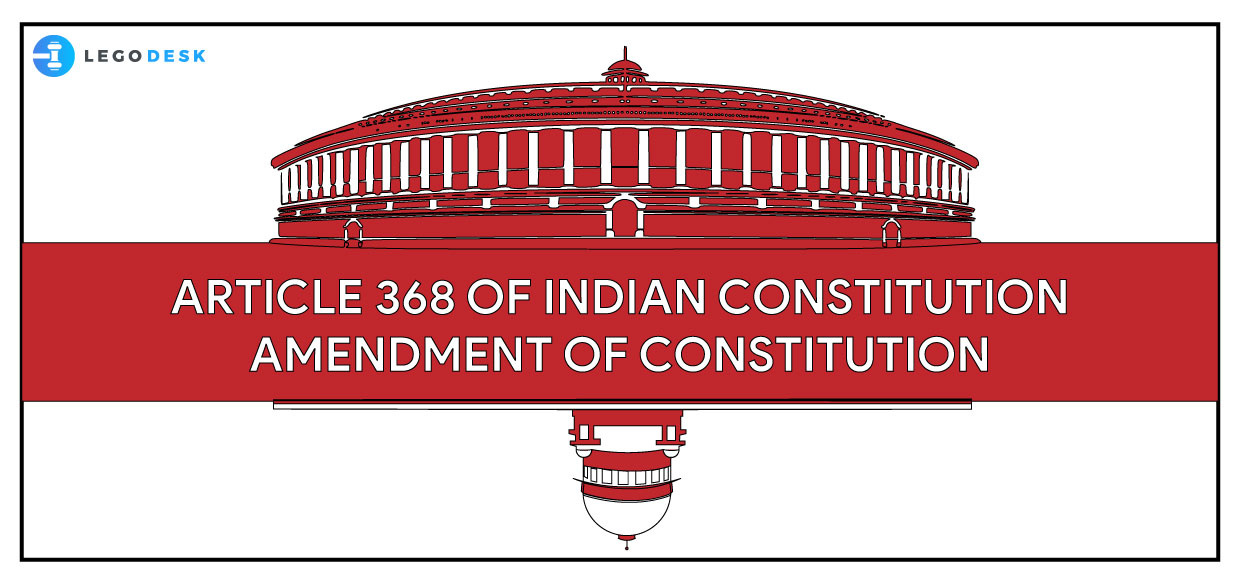Article 368 of the Indian Constitution
Pandit Jawaharlal Nehru, India’s First Prime Minister, had once said that the Constitution should not be so rigid that it fails to adapt itself to the changing needs of national development and strength. Therefore, the amendment to the Constitution was thought to be a necessity for the Constitution makers. Article 368 of the Indian Constitution deals with the amendment procedure. A major feature of the Constitution of India is that it is neither too rigid nor too flexible. It allows modifications to be made since time is not static. Societies evolve with time, and the law needs to adapt to the same.
Procedure for Amendment
- An amendment to the Constitution of India may be allowed by the introduction of a Bill for the purpose in either House of the Parliament (Lok Sabha or Rajya Sabha). The bill has to be passed in each house by a majority, which is more than 50% of the total membership of that House and by a majority of not less than two-thirds of the members of the House present and voting.
- Then the Bill goes to the President of India for his assent and when such assent is given, the Bill becomes an Act.
Features of the Amending Procedure
The procedure for amendment in India is not as plicated as the system in the U.S.A or in any other rigid Constitution.
- Our Constitution vests constituent power upon the ordinary legislature, i.e., the Parliament of India and there is no separate body that functions for amending the Constitution of India.
- The State Legislatures do not have the authority to initiate any Bill or proposal for amending the Constitution of India. The only procedure is initiating the Bill through the Union Legislature, i.e., the Parliament of India.
- Subject to the provisions of Article 368, the Amendment Bills to the Constitution of India can be passed in the same way as ordinary Bills in the Parliament of India.
- Prior sanction of the President of India is not required for introducing any Bill in the Parliament for amendment of the Constitution of India.
- Ratification by not less than half of the States.
Landmark Supreme Court judgments
Shankari Prasad v. Union of India was the first time when the question of whether Fundamental Rights enshrined under Part III of the Constitution of India, can be amended under Article 368. In this case, the validity of the First Constitutional Amendment was challenged, which had added Article 31A and 31B to the Constitution of India. The Five Judge Bench had stated. Article 368 provides for general and strict power to the Parliament of India to amend the Constitution.
Sajjan Singh v. the State of Rajasthan was a case where the validity of the Seventeenth Amendment was challenged. The question raised before the court was that if the seventeenth amendment limits the jurisdiction of High Courts. The apex court quashed the contention. However, the second contention was that even if Article 368 does not expressly declare that power of the Parliament regarding the amendment of Fundamental Rights, the Parliament of India can assume those powers by virtue of a suitable amendment.
Golaknath v. State of Punjab was the case where three amendments, namely, the first, fourth, and seventeenth amendments, were challenged. The bench had eleven judges out of which the majority six-judge bench held that Part 3 of the Constitution (Fundamental Rights) could not be amended by the Parliament of India. Post this judgment of the apex court, and the 24th Amendment was passed in the year 1971, which introduced a change in Article 13 and 368 of the Constitution of India.
Keshvananda Bharati v. Union of India was a landmark case where for the first time, the Supreme Court brought in the doctrine of Basic Structure. The court overruled the judgment of the Golaknath case, and the validity of the 24th, 25th, and the 29th amendment was questioned. Also, the apex court held that article 368 of the Constitution does not empower the Parliament to change, damage, or alter the basic structure of the Constitution of India. The Preamble is actually the basic structure of the Constitution of India.
The same judgment was followed in the case of Indira Nehru Gandhi v. Raj Narayan.
42nd Amendment
42nd Amendment to the Constitution of India added the words “secular” and “socialist” to the Constitution of India and added clause 4 and 5 to Article 368. This amendment recognized the ultimate power of the Parliament in amending the Constitution of India even after the Supreme Court judgments of Keshvananda Bharati and Raj Narayan.
CONCLUSION
Article 368 of the Constitution of India provides for the procedure of Amendment to the Constitution of India. The Constitution is neither too rigid nor too flexible. As of March 2019, there have been 103 amendments to the Constitution of India since 1950. The latest amendment amended article 15 and 16 of the Constitution of India which provides for a maximum reservation of 10% for economically weaker sections of classes other than the ones mentioned under clause (4) and clause (5) of Article 15. The Supreme Court has tried to put restrictions to the power of the Parliament through some of its judgments, but the 42nd Amendment went against it. Article 368 itself is silent on the fact whether the Parliament has the authority to amend the basic structure of the Constitution or not.

